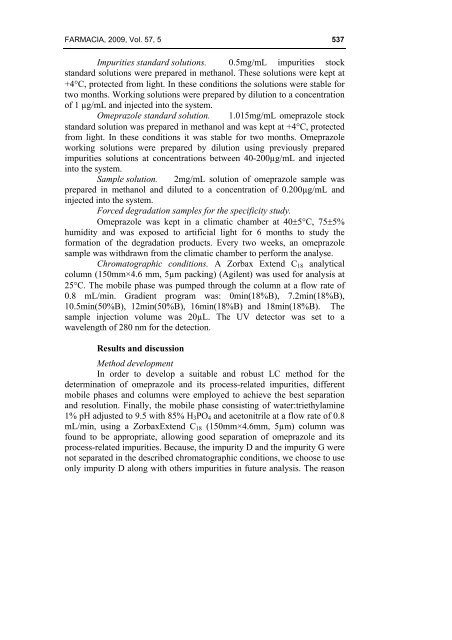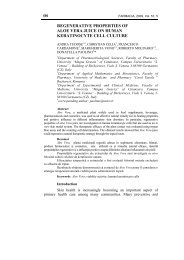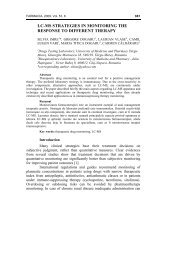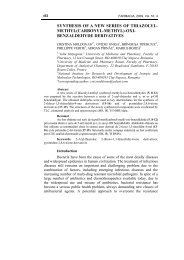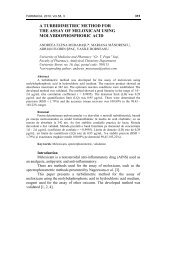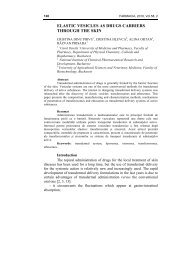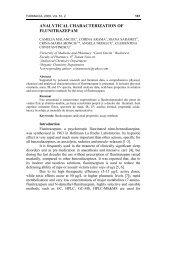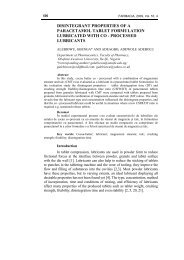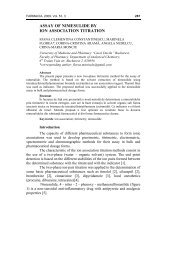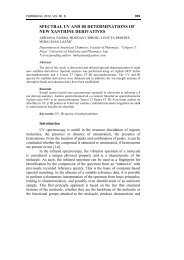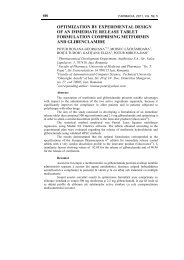development of a validated rp-hplc method for separation - farmacia
development of a validated rp-hplc method for separation - farmacia
development of a validated rp-hplc method for separation - farmacia
Create successful ePaper yourself
Turn your PDF publications into a flip-book with our unique Google optimized e-Paper software.
FARMACIA, 2009, Vol. 57, 5 537<br />
Impurities standard solutions. 0.5mg/mL impurities stock<br />
standard solutions were prepared in methanol. These solutions were kept at<br />
+4°C, protected from light. In these conditions the solutions were stable <strong>for</strong><br />
two months. Working solutions were prepared by dilution to a concentration<br />
<strong>of</strong> 1 µg/mL and injected into the system.<br />
Omeprazole standard solution. 1.015mg/mL omeprazole stock<br />
standard solution was prepared in methanol and was kept at +4°C, protected<br />
from light. In these conditions it was stable <strong>for</strong> two months. Omeprazole<br />
working solutions were prepared by dilution using previously prepared<br />
impurities solutions at concentrations between 40-200µg/mL and injected<br />
into the system.<br />
Sample solution. 2mg/mL solution <strong>of</strong> omeprazole sample was<br />
prepared in methanol and diluted to a concentration <strong>of</strong> 0.200µg/mL and<br />
injected into the system.<br />
Forced degradation samples <strong>for</strong> the specificity study.<br />
Omeprazole was kept in a climatic chamber at 40±5°C, 75±5%<br />
humidity and was exposed to artificial light <strong>for</strong> 6 months to study the<br />
<strong>for</strong>mation <strong>of</strong> the degradation products. Every two weeks, an omeprazole<br />
sample was withdrawn from the climatic chamber to per<strong>for</strong>m the analyse.<br />
Chromatographic conditions. A Zorbax Extend C 18 analytical<br />
column (150mm×4.6 mm, 5µm packing) (Agilent) was used <strong>for</strong> analysis at<br />
25°C. The mobile phase was pumped through the column at a flow rate <strong>of</strong><br />
0.8 mL/min. Gradient program was: 0min(18%B), 7.2min(18%B),<br />
10.5min(50%B), 12min(50%B), 16min(18%B) and 18min(18%B). The<br />
sample injection volume was 20µL. The UV detector was set to a<br />
wavelength <strong>of</strong> 280 nm <strong>for</strong> the detection.<br />
Results and discussion<br />
Method <strong>development</strong><br />
In order to develop a suitable and robust LC <strong>method</strong> <strong>for</strong> the<br />
determination <strong>of</strong> omeprazole and its process-related impurities, different<br />
mobile phases and columns were employed to achieve the best <strong>separation</strong><br />
and resolution. Finally, the mobile phase consisting <strong>of</strong> water:triethylamine<br />
1% pH adjusted to 9.5 with 85% H 3 PO 4 and acetonitrile at a flow rate <strong>of</strong> 0.8<br />
mL/min, using a ZorbaxExtend C 18 (150mm×4.6mm, 5µm) column was<br />
found to be appropriate, allowing good <strong>separation</strong> <strong>of</strong> omeprazole and its<br />
process-related impurities. Because, the impurity D and the impurity G were<br />
not separated in the described chromatographic conditions, we choose to use<br />
only impurity D along with others impurities in future analysis. The reason


